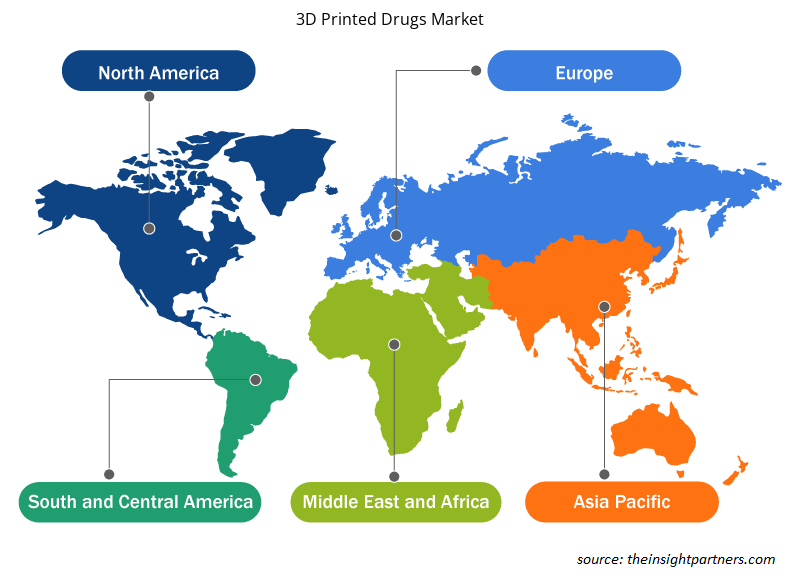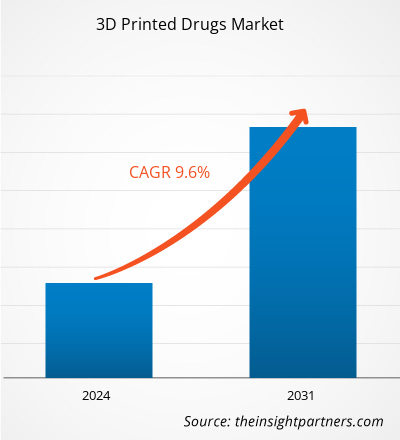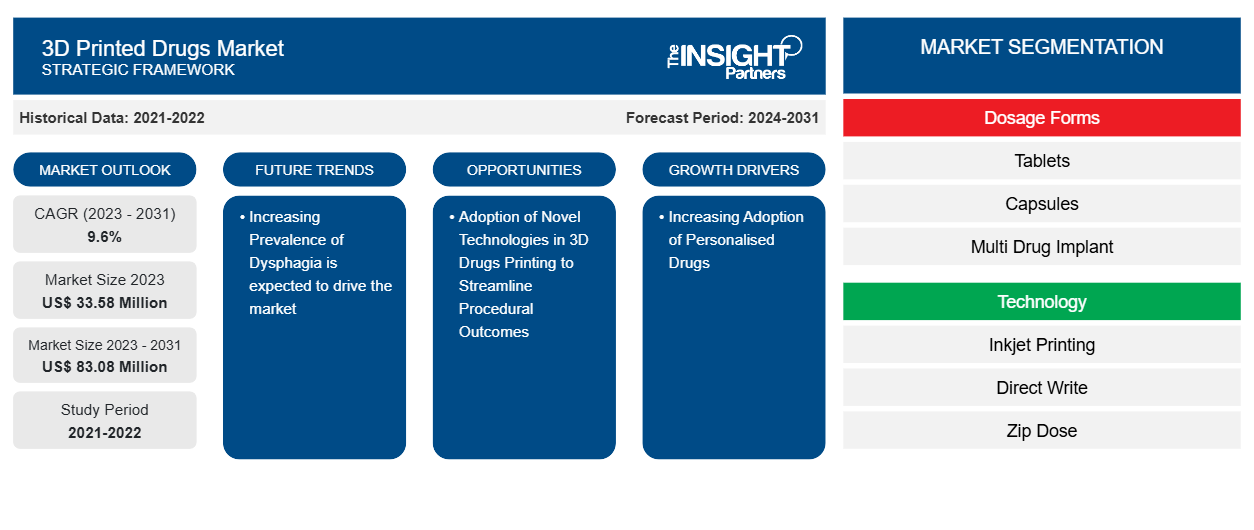Das Marktvolumen für 3D-gedruckte Medikamente soll von 33,58 Millionen US-Dollar im Jahr 2023 auf 83,08 Millionen US-Dollar im Jahr 2031 anwachsen. Für den Zeitraum 2023–2031 wird eine durchschnittliche jährliche Wachstumsrate (CAGR) von 9,6 % erwartet.Die Einführung neuer Technologien im 3D-Druck von Arzneimitteln zur Optimierung der Verfahrensergebnisse wird voraussichtlich ein wichtiger Markttrend für 3D-gedruckte Arzneimittel bleiben.
Marktanalyse für 3D-gedruckte Medikamente
Ein 3D-gedrucktes Medikament ist ein pharmazeutisches Produkt, das mithilfe der 3D-Drucktechnologie hergestellt wird, die aus der digitalen Datei einen 3D-Festkörper erstellt. 3D-gedruckte Medikamente spielen eine wichtige Rolle in der personalisierten Medizin. Die Technologie hilft auch bei der Untersuchung maßgeschneiderter Arzneimittelfreisetzungsprofile. Es handelt sich um die digitale Datei, die Informationen über das gewünschte Arzneimittelfreisetzungsprofil für 3D-gedruckte Medikamente enthält. Das Profil enthält die folgenden Informationen: Arzneimittelkonzentration, Freisetzungsrate und -kinetik, zeitabhängiges Freisetzungsprofil und Materialeigenschaften. Dies wird dazu beitragen, personalisierte Medikamente mit präziser Arzneimittelverabreichung zu entwickeln, was zu verbesserter Effizienz, erhöhter Patienten-Compliance und weniger Nebenwirkungen führt.
Marktübersicht für 3D-gedruckte Medikamente
3D-gedruckte Medikamente beziehen sich auf Arzneimittel, die mithilfe der 3D-Drucktechnologie hergestellt werden, die die präzise Herstellung komplexer Strukturen und eine individuelle Dosierung ermöglicht. Dieser Ansatz bietet verschiedene Vorteile wie personalisierte Medizin, komplexe Geometrien, schnelles Prototyping, Produktion auf Abruf und verbesserte Medikamentenverabreichung. Spritam und ZipDose sind einige Beispiele für 3D-gedruckte Medikamente. Das Wachstum des Marktes wird auf wichtige treibende Faktoren zurückgeführt, wie das zunehmende Bewusstsein für 3D-Druck und stark wachsende Entwicklungen in der 3D-Druckforschung. Die eingeschränkte Nutzung aufgrund der illegalen Medikamentenherstellung wird sich jedoch im Prognosezeitraum wahrscheinlich negativ auf das Marktwachstum auswirken.
Passen Sie diesen Bericht Ihren Anforderungen an
Sie erhalten kostenlos individuelle Anpassungen an jedem Bericht, einschließlich Teilen dieses Berichts oder einer Analyse auf Länderebene, eines Excel-Datenpakets sowie tolle Angebote und Rabatte für Start-ups und Universitäten.
-
Holen Sie sich die wichtigsten Markttrends aus diesem Bericht.Dieses KOSTENLOSE Beispiel umfasst eine Datenanalyse von Markttrends bis hin zu Schätzungen und Prognosen.
Markttreiber und Chancen für 3D-gedruckte Medikamente
Zunehmende Dysphagieprävalenz begünstigt Markt
Die Weltbevölkerung wächst, und Prognosen zufolge wird es bis 2050 2 Milliarden Menschen über 65 Jahre geben; der größte proportionale Anstieg wird bei den über 85-Jährigen zu verzeichnen sein. Verschiedene epidemiologische Berichte weisen darauf hin, dass Dysphagie bei älteren Menschen und Kindern weit verbreitet ist. Laut den Statistiken des CDC erleiden in den USA jedes Jahr über 795.000 Menschen einen Schlaganfall, wobei 50 % der Schlaganfallpatienten mit Schluckstörungen in Verbindung stehen. Darüber hinaus sind verschiedene neurologische Erkrankungen bekannt, die mit Dysphagie in Verbindung stehen. Aufgrund der porösen Struktur von 3D-gedruckten Medikamenten zerfallen sie leicht in der Mundhöhle. Daher ist diese Form der Medikation hilfreich für Patienten, die häufig Schluckbeschwerden haben, was wiederum das Marktwachstum im Prognosezeitraum vorantreibt.
Schwellenmärkte in Entwicklungsländern
3D-Drucktechnologien werden in vielen Bereichen eingesetzt, darunter in der Modebranche, im Bauwesen, in der Luft- und Raumfahrt und in vielen anderen Branchen. Im medizinischen Bereich wird sie vor allem in der Zahnmedizin und im Tissue Engineering eingesetzt. Der Einsatz der 3D-Drucktechnologie im pharmazeutischen Bereich ist jedoch relativ neu. Viele Geschäftsbereiche nutzen die Leistungsfähigkeit der 3D-Drucktechnologie, und Experten sagen voraus, dass 3D-gedruckte (3DP) Medikamente die Pharmabranche im Prognosezeitraum revolutionieren werden. Mit der Präzisionsmedizin bietet sich eine echte Chance, die Dosisgröße für einen bestimmten Patienten zu skalieren und anzupassen. Viele Pharmaunternehmen sehen enorme Chancen und größere Flexibilität bei der Entwicklung von Darreichungsformen, die den spezifischen Bedürfnissen der Patienten entsprechen. So ist beispielsweise Aprecia mit Sitz in Cincinnati ein Pharmaunternehmen, das sich auf 3DP-Arzneimittel spezialisiert hat. Darüber hinaus gaben Merck und AMCM aus Starnberg im Februar 2020 eine Kooperationsvereinbarung zum 3D-Druck von Tabletten bekannt. Solche Aktivitäten werden voraussichtlich im Prognosezeitraum lukrative Möglichkeiten für Hersteller von 3D-gedruckten Medikamenten bieten.
Marktbericht über 3D-gedruckte Medikamente – Segmentierungsanalyse
Wichtige Segmente, die zur Ableitung der Marktanalyse für 3D-gedruckte Medikamente beigetragen haben, sind Typ, Anwendung und Endbenutzer.
- Basierend auf dem Harztyp ist der Markt für 3D-gedruckte Medikamente in Tabletten, Kapseln, Multi-Medikamentenimplantate, Nanopartikel, Lösungen und andere Darreichungsformen unterteilt. Das Tablettensegment hatte 2023 den größten Marktanteil; außerdem wird erwartet, dass dasselbe Segment im Prognosezeitraum den höchsten CAGR-Prozentsatz auf dem Markt verzeichnet.
- Nach Technologietyp ist der Markt in Tintenstrahldruck, Direktschreiben, Zipdose, thermischen Tintenstrahldruck, Fused Deposition Modeling, Pulverbettdruck, Stereolithografie (SLA) und halbfeste Extrusion (SSE) unterteilt. Das Zipdose-Segment hatte 2023 den größten Marktanteil.
Marktanteilsanalyse für 3D-gedruckte Medikamente nach geografischer Lage
Der geografische Umfang des Marktberichts für 3D-gedruckte Medikamente ist hauptsächlich in fünf Regionen unterteilt: Nordamerika, Asien-Pazifik, Europa, Naher Osten und Afrika sowie Süd- und Mittelamerika. Nordamerika hat den Markt für 3D-gedruckte Medikamente dominiert. Das Wachstum der staatlichen und privaten Finanzierung der Gesundheitsinfrastruktur, das wachsende Bewusstsein für die Medikamente und das gestiegene technologische Bewusstsein in der Pharmaindustrie gehören zu den wenigen Faktoren, die das Wachstum des nordamerikanischen Marktes für 3D-gedruckte Medikamente beschleunigen sollen. Mehrere Unternehmen tätigen umfangreiche F&E-Ausgaben, um das Marktwachstum durch bedeutende Produktentwicklungen und Innovationen anzukurbeln. Der Markt betrachtet strategische Unternehmen und Kooperationen als lukrativen Weg zur Ausweitung der Marktpräsenz durch Nutzung der verschiedenen Fähigkeiten und Fachkenntnisse der anderen Unternehmen auf dem Markt. So war beispielsweise Organovo, ein medizinisches Labor- und Forschungsunternehmen, führend bei der F&E des 3D-Biodrucks im Land. Darüber hinaus wendet sich das Unternehmen Anfang 2020 mit einem Antrag auf ein neues Prüfpräparat (IND) an die FDA, in dem sein biogedrucktes Lebergewebe zur Behandlung seltener Krankheiten eingesetzt werden kann.
Regionale Einblicke in den Markt für 3D-gedruckte Medikamente
Die regionalen Trends und Faktoren, die den Markt für 3D-gedruckte Medikamente im Prognosezeitraum beeinflussen, wurden von den Analysten von Insight Partners ausführlich erläutert. In diesem Abschnitt werden auch Marktsegmente und Geografien für 3D-gedruckte Medikamente in Nordamerika, Europa, im asiatisch-pazifischen Raum, im Nahen Osten und Afrika sowie in Süd- und Mittelamerika erörtert.

- Erhalten Sie regionale Daten zum Markt für 3D-gedruckte Medikamente
Umfang des Marktberichts über 3D-gedruckte Medikamente
| Berichtsattribut | Details |
|---|---|
| Marktgröße im Jahr 2023 | 33,58 Millionen US-Dollar |
| Marktgröße bis 2031 | 83,08 Millionen US-Dollar |
| Globale CAGR (2023 - 2031) | 9,6 % |
| Historische Daten | 2021-2022 |
| Prognosezeitraum | 2024–2031 |
| Abgedeckte Segmente |
Nach Darreichungsform
|
| Abgedeckte Regionen und Länder |
Nordamerika
|
| Marktführer und wichtige Unternehmensprofile |
|
Marktteilnehmerdichte für 3D-gedruckte Medikamente: Auswirkungen auf die Geschäftsdynamik verstehen
Der Markt für 3D-gedruckte Medikamente wächst rasant. Die Nachfrage der Endverbraucher steigt aufgrund von Faktoren wie sich entwickelnden Verbraucherpräferenzen, technologischen Fortschritten und einem größeren Bewusstsein für die Vorteile des Produkts. Mit der steigenden Nachfrage erweitern Unternehmen ihr Angebot, entwickeln Innovationen, um die Bedürfnisse der Verbraucher zu erfüllen, und nutzen neue Trends, was das Marktwachstum weiter ankurbelt.
Die Marktteilnehmerdichte bezieht sich auf die Verteilung der Firmen oder Unternehmen, die in einem bestimmten Markt oder einer bestimmten Branche tätig sind. Sie gibt an, wie viele Wettbewerber (Marktteilnehmer) in einem bestimmten Marktraum im Verhältnis zu seiner Größe oder seinem gesamten Marktwert präsent sind.
Die wichtigsten Unternehmen auf dem Markt für 3D-gedruckte Medikamente sind:
- APRECIA PHARMACEUTICALS, LLC
- FabRx LTD
- Zykluspharmazeutika
- GLAXOSMITHKLINE PLC.
- ASTRAZENECA
- Tvasta
Haftungsausschluss : Die oben aufgeführten Unternehmen sind nicht in einer bestimmten Reihenfolge aufgeführt.

- Überblick über die wichtigsten Akteure auf dem Markt für 3D-gedruckte Medikamente
(BEHALTEN SIE DIESES SCHLÜSSELWORT HIER FÜR SHYAM)
„
FÜGEN SIE HIER KEINE TABELLE HINZU
”
Neuigkeiten und aktuelle Entwicklungen zum Markt für 3D-gedruckte Medikamente
Der Markt für 3D-gedruckte Medikamente wird durch die Erfassung qualitativer und quantitativer Daten nach Primär- und Sekundärforschung bewertet, die wichtige Unternehmensveröffentlichungen, Verbandsdaten und Datenbanken umfasst. Im Folgenden finden Sie eine Liste der Entwicklungen auf dem Markt für Innovationen, Geschäftserweiterungen und Strategien:
- Im Oktober 2023 hat das finnische Healthtech-Unternehmen CurifyLabs die Einführung der weltweit ersten GMP-konformen (Good Manufacturing Practice) Pharma-Tinten für 3D-druckbare Medikamente angekündigt. Das Pharma Kit von CurifyLabs, das automatisierte 3D-Drucktechnologie und druckbare pharmazeutische Tinten umfasst, ermöglicht eine breitere Einführung personalisierter Medizin und führt laut dem Unternehmen zu einer besseren zukünftigen Versorgung von Patienten mit unterschiedlichen Bedürfnissen. (Quelle: CurifyLabs, Pressemitteilung)
- Im September 2023 bringt die LSMU (Litauische Universität für Gesundheitswissenschaften) den ersten validierten pharmazeutischen 3D-Drucker auf den Markt. Das neue Gerät setzt neue Maßstäbe für die Innovationsentwicklung in der Pharmatechnologie. Es ermöglicht die Herstellung personalisierter, auf jeden einzelnen Patienten zugeschnittener Medikamente, die Steigerung der Wirksamkeit von Medikamenten durch die Kombination mehrerer Substanzen in einer einzigen Tablette und die Verringerung der Nebenwirkungen von Medikamenten. (Quelle: LSMU, Pressemitteilung)
Marktbericht zu 3D-gedruckten Medikamenten – Umfang und Ergebnisse
Der Bericht „Marktgröße und Prognose für 3D-gedruckte Medikamente (2021–2031)“ bietet eine detaillierte Analyse des Marktes, die die folgenden Bereiche abdeckt:
- 3D-gedruckte Medikamente Marktgröße und Prognose auf globaler, regionaler und Länderebene für alle wichtigen Marktsegmente, die im Rahmen des Berichts abgedeckt sind
- Marktdynamik wie Treiber, Beschränkungen und wichtige Chancen
- 3D-gedruckte Medikamente Markttrends
- Detaillierte PEST- und SWOT-Analyse
- Marktanalyse für 3D-gedruckte Medikamente, die wichtige Markttrends, globale und regionale Rahmenbedingungen, wichtige Akteure, Vorschriften und aktuelle Marktentwicklungen abdeckt.
- Branchenlandschaft und Wettbewerbsanalyse für 3D-gedruckte Medikamente, einschließlich Marktkonzentration, Heatmap-Analyse, prominenten Akteuren und aktuellen Entwicklungen.
- Detaillierte Firmenprofile
- Historische Analyse (2 Jahre), Basisjahr, Prognose (7 Jahre) mit CAGR
- PEST- und SWOT-Analyse
- Marktgröße Wert/Volumen – Global, Regional, Land
- Branchen- und Wettbewerbslandschaft
- Excel-Datensatz
Aktuelle Berichte
Verwandte Berichte
Erfahrungsberichte
Grund zum Kauf
- Fundierte Entscheidungsfindung
- Marktdynamik verstehen
- Wettbewerbsanalyse
- Kundeneinblicke
- Marktprognosen
- Risikominimierung
- Strategische Planung
- Investitionsbegründung
- Identifizierung neuer Märkte
- Verbesserung von Marketingstrategien
- Steigerung der Betriebseffizienz
- Anpassung an regulatorische Trends























 Kostenlose Probe anfordern für - Markt für 3D-gedruckte Medikamente
Kostenlose Probe anfordern für - Markt für 3D-gedruckte Medikamente